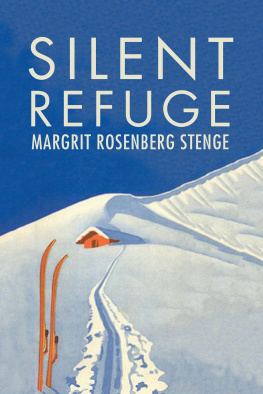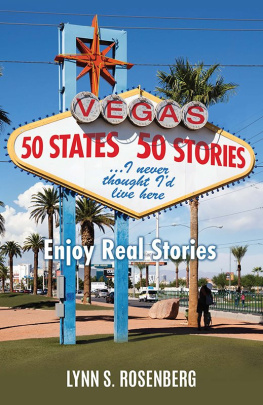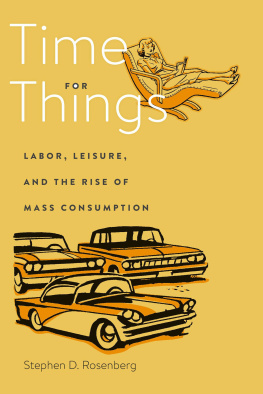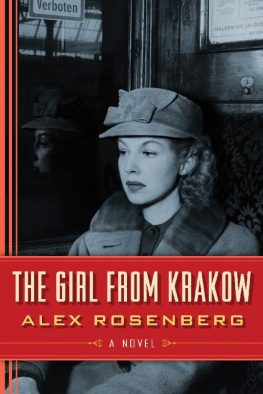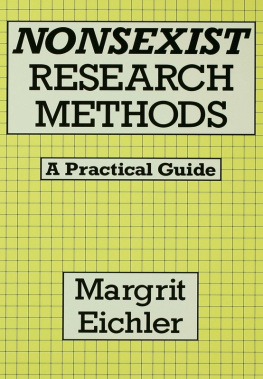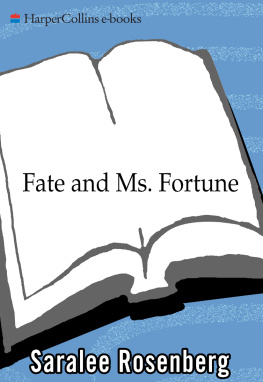Margrit Rosenberg Stenge - Silent Refuge
Here you can read online Margrit Rosenberg Stenge - Silent Refuge full text of the book (entire story) in english for free. Download pdf and epub, get meaning, cover and reviews about this ebook. year: 2017, publisher: Azrieli Foundation, genre: History. Description of the work, (preface) as well as reviews are available. Best literature library LitArk.com created for fans of good reading and offers a wide selection of genres:
Romance novel
Science fiction
Adventure
Detective
Science
History
Home and family
Prose
Art
Politics
Computer
Non-fiction
Religion
Business
Children
Humor
Choose a favorite category and find really read worthwhile books. Enjoy immersion in the world of imagination, feel the emotions of the characters or learn something new for yourself, make an fascinating discovery.
- Book:Silent Refuge
- Author:
- Publisher:Azrieli Foundation
- Genre:
- Year:2017
- Rating:5 / 5
- Favourites:Add to favourites
- Your mark:
- 100
- 1
- 2
- 3
- 4
- 5
Silent Refuge: summary, description and annotation
We offer to read an annotation, description, summary or preface (depends on what the author of the book "Silent Refuge" wrote himself). If you haven't found the necessary information about the book — write in the comments, we will try to find it.
Silent Refuge — read online for free the complete book (whole text) full work
Below is the text of the book, divided by pages. System saving the place of the last page read, allows you to conveniently read the book "Silent Refuge" online for free, without having to search again every time where you left off. Put a bookmark, and you can go to the page where you finished reading at any time.
Font size:
Interval:
Bookmark:

Silent Refuge
Margrit Rosenberg Stenge
Naomi Azrieli, Publisher
Jody Spiegel, Program Director
Arielle Berger, Managing Editor
Farla Klaiman, Editor
Matt Carrington, Editor
Elizabeth Lasserre, Senior Editor, French-Language Editions
Elin Beaumont, Senior Education Outreach and Program Facilitator
Catherine Person, Educational Outreach and Events Coordinator, Quebec and French Canada
Stephanie Corazza, Education and Curriculum Associate
Marc-Olivier Cloutier, Educational Outreach and Events Assistant, Quebec and French Canada
Tim MacKay, Digital Platform Manager
Elizabeth Banks, Digital Asset Curator and Archivist
Susan Roitman, Office Manager (Toronto)
Mary Mellas, Executive Assistant and Human Resources (Montreal)
Mark Goldstein, Art Director
Franois Blanc, Cartographer
Bruno Paradis, Layout, French-Language Editions
In telling these stories, the writers have liberated themselves. For so many years we did not speak about it, even when we became free people living in a free society. Now, when at last we are writing about what happened to us in this dark period of history, knowing that our stories will be read and live on, it is possible for us to feel truly free. These unique historical documents put a face on what was lost, and allow readers to grasp the enormity of what happened to six million Jews-one story at a time.
David J. Azrieli, C.M., C.Q., M.Arch
Holocaust survivor and founder, The Azrieli Foundation
Since the end of World War ii , over 30,000 Jewish Holocaust survivors have immigrated to Canada. Who they are, where they came from, what they experienced and how they built new lives for themselves and their families are important parts of our Canadian heritage. The Azrieli Foundations Holocaust Survivor Memoirs Program was established to preserve and share the memoirs written by those who survived the twentieth-century Nazi genocide of the Jews of Europe and later made their way to Canada. The program is guided by the conviction that each survivor of the Holocaust has a remarkable story to tell, and that such stories play an important role in education about tolerance and diversity.
Millions of individual stories are lost to us forever. By preserving the stories written by survivors and making them widely available to a broad audience, the Azrieli Foundations Holocaust Survivor Memoirs Program seeks to sustain the memory of all those who perished at the hands of hatred, abetted by indifference and apathy. The personal accounts of those who survived against all odds are as different as the people who wrote them, but all demonstrate the courage, strength, wit and luck that it took to prevail and survive in such terrible adversity. The memoirs are also moving tributes to people - strangers and friends - who risked their lives to help others, and who, through acts of kindness and decency in the darkest of moments, frequently helped the persecuted maintain faith in humanity and courage to endure. These accounts offer inspiration to all, as does the survivors desire to share their experiences so that new generations can learn from them.
The Holocaust Survivor Memoirs Program collects, archives and publishes these distinctive records and the print editions are available free of charge to educational institutions and Holocaust-education programs across Canada. They are also available for sale to the general public at bookstores. All revenues to the Azrieli Foundation from the sales of the Azrieli Series of Holocaust Survivor Memoirs go toward the publishing and educational work of the memoirs program.
The Azrieli Foundation would like to express appreciation to the following people for their invaluable efforts in producing this book: Doris Bergen, Sherry Dodson (Maracle Inc), Barbara Kamieski, Karen Kligman, Therese Parent, and Margie Wolfe and Emma Rodgers of Second Story Press.
The following memoir contains a number of terms, concepts and historical references that may be unfamiliar to the reader. For information on major organizations; significant historical events and people; geographical locations; religious and cultural terms; and foreign-language words and expressions that will help give context and background to the events described in the text, please see the .
Margrit Rosenberg Stenges memoir, Silent Refuge, finds its place within the much larger story of Holocaust memory. Arriving in Canada in 1951, she and her husband are two of the close to 40,000 Jews who found post-war refuge in Canada.
The story of the Holocaust is now quite a prominent part of our culture. Impressive institutions devote themselves to Holocaust memory, institutions such as the United States Holocaust Memorial Museum in Washington, DC, or Yad Vashem in Jerusalem, Israel. Even in Berlin, the city where Germans planned and instigated the horrors of the Holocaust, there is both a Holocaust memorial and a Jewish museum with exhibits that highlight the history of the Holocaust. Narratives of the Holocaust have also become a part of popular culture, starting with Steven Spielbergs 1993 film, Schindlers List.
It was not always so. In the first decades after Nazi Germany collapsed in 1945, Jewish survivors rarely talked about their experiences. This silence was at least partially self-protective, as they tried to stifle recurring nightmares or other symptoms of post-traumatic stress. Additionally, however, survivors often discovered that many people did not want to hear their horrific stories, or, worse yet, did not fully believe them. Escape from Sobibor then became a bbc -produced film in 1987, starring Alan Arkin and Rutger Hauer among others. Thomas Blatt assisted in the creation of that film. Finally, in 1997, Blatt was able to publish his own memoir, From the Ashes of Sobibor.
Awareness of the Holocaust did not begin in the 1980s, of course. Newspaper stories appeared even as the Nazi persecution of Jews was taking place. Finally, in the summer of 1945, the story burst upon the pages of newspapers and magazines when photojournalists such as Lee Miller and Margaret Bourke-White followed Allied troops to camps such as Dachau, Buchenwald and Mauthausen. After years of rumours and partially buried press reports on horrible conditions and mass murder, this physical evidence shocked Allied troops. When photojournalists placed their photos in publications such as Life magazine, the images shocked the world. The first of the Nuremberg Trials, held from November 1945 until October 1946, then received considerable news coverage and added to the body of evidence available to observers.
Despite the enormity of this story, awareness of the Holocaust receded after the war. This near disappearance of Holocaust memory was rectified first by historians. The enterprising scholarship of historians such as Raul Hilberg, whose book The Destruction of the European Jews appeared in 1961, and Christopher Browning, who, along with many other critical works, published his path-breaking study, Ordinary Men: Reserve Police Battalion 101 and the Holocaust in Poland in 1998, created what is now known as the field of Holocaust Studies. Since the beginning of Hilbergs work in the 1950s, and Brownings in the 1970s, the number of Holocaust scholars has grown extensively. While historians followed the lead of Hilberg and Browning, adding to our store of Holocaust memory, scholars in literature, religion, psychology, political science, sociology, art and other fields studied the Holocaust through their own lenses. Together these individuals have built our scholarly foundation for Holocaust memory. There is another essential source for Holocaust memory, however: people like Margrit Rosenberg Stenge who personally remember it. She and many others can tell us about the Holocaust because they are the ones who experienced it.
Font size:
Interval:
Bookmark:
Similar books «Silent Refuge»
Look at similar books to Silent Refuge. We have selected literature similar in name and meaning in the hope of providing readers with more options to find new, interesting, not yet read works.
Discussion, reviews of the book Silent Refuge and just readers' own opinions. Leave your comments, write what you think about the work, its meaning or the main characters. Specify what exactly you liked and what you didn't like, and why you think so.

